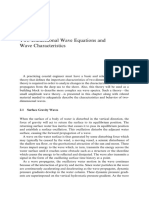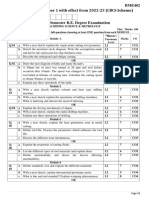Module 5
Uploaded by
gifteze09028265516Module 5
Uploaded by
gifteze090282655161
Module 5
CIV 532
RIVER & COASTAL ENGINEERING
Wave Power
Wave power is the wave energy per unit time propagated in the direction of wave travel.
Alternatively, wave power can be expressed as the product of the force of wave propagation acting
normal on a vertical plane and the particle flow velocity across the plane.
z
L,T
𝒅𝒛
𝝆𝒈𝜼 Still water level (SWL) : z=0, u=0 (KSBC)
O H x
𝑯
𝑨 = Wave amplitude = 𝟐
w
u
Kinematic Bottom : 𝒛 = −𝒅, 𝒘 = 𝟎 (KBBC)
𝝆𝒈𝒅 𝝆𝒈𝜼 𝝆𝒈𝒅 𝝆𝒈𝜼
𝒄𝒐𝒔𝒉(𝒌𝒅) 𝒄𝒐𝒔𝒉(𝒌𝒅)
Figure 1: Pressure distribution profile of water waves
𝑊𝑜𝑟𝑘𝑑𝑜𝑛𝑒 𝐹𝑜𝑟𝑐𝑒 × 𝐷𝑖𝑠𝑡𝑎𝑛𝑐𝑒
𝑊𝑎𝑣𝑒 𝑃𝑜𝑤𝑒𝑟 (𝑃𝑤𝑎𝑣𝑒 ) = =
𝑇𝑖𝑚𝑒 𝑡𝑎𝑘𝑒𝑛 𝑇𝑖𝑚𝑒 𝑡𝑎𝑘𝑒𝑛
𝑑𝑥 𝑢𝑑𝑡 1
𝑑𝑃𝑤𝑎𝑣𝑒 = 𝑑𝐹 × = 𝑝𝑤𝑎𝑣𝑒 𝑑𝐴 ( ) = 𝑝𝑤𝑎𝑣𝑒 𝑢𝑑𝑦𝑑𝑧𝑑𝑡
𝑇 𝑇 𝑇
For a unit crest width, the elemental average wave power is:
1
𝑑𝑃𝑤𝑎𝑣𝑒 = 𝑝𝑤𝑎𝑣𝑒 𝑢𝑑𝑧𝑑𝑡
𝑇
𝑡=𝑇 𝑧=𝑜
1
𝑃𝑤𝑎𝑣𝑒 = ∫ ∫ 𝑝𝑤𝑎𝑣𝑒 𝑢𝑑𝑧𝑑𝑡
𝑇
𝑡=0 𝑧=−𝑑
𝜕𝜑 𝐻 𝑐𝑜𝑠ℎ[𝑘(𝑑+𝑧)]
But 𝑝𝑤𝑎𝑣𝑒 = −𝜌 = 𝑝 + 𝜌𝑔𝑧 = 𝜌𝑔 𝑠𝑖𝑛 (𝜔𝑡 − 𝑘𝑥 )
𝜕𝑡 2 𝑐𝑜𝑠ℎ(𝑘𝑑)
𝑡=𝑇 𝑧=𝑜
1
𝑃𝑤𝑎𝑣𝑒 = ∫ ∫ (𝑝 + 𝜌𝑔𝑧)𝑢𝑑𝑧𝑑𝑡 (1)
𝑇
𝑡=0 𝑧=−𝑑
𝑝𝑤𝑎𝑣𝑒 = (𝑝 + 𝜌𝑔𝑧) is the dynamic or wave-induced pressure and 𝑢 is the particle horizontal
component velocity
Lecturer: Engr. Samuel
2
𝜋𝐻 𝑐𝑜𝑠ℎ[𝑘(𝑑+𝑧)] 𝐻 𝑐𝑜𝑠ℎ[𝑘(𝑑+𝑧)]
Putting 𝑢 = 𝑠𝑖𝑛 (𝜔𝑡 − 𝑘𝑥 ) and 𝑝 + 𝜌𝑔𝑧 = 𝜌𝑔 𝑠𝑖𝑛 (𝜔𝑡 − 𝑘𝑥 ) into
𝑇 𝑠𝑖𝑛ℎ(𝑘𝑑) 2 𝑐𝑜𝑠ℎ(𝑘𝑑)
eqn. (1)
𝑡=𝑇 𝑧=𝑜
1 𝐻 𝑐𝑜𝑠ℎ[𝑘(𝑑 + 𝑧)] 𝜋𝐻 𝑐𝑜𝑠ℎ[𝑘(𝑑 + 𝑧)]
𝑃𝑤𝑎𝑣𝑒 = ∫ ∫ {𝜌𝑔 𝑠𝑖𝑛(𝜔𝑡 − 𝑘𝑥 )} { 𝑠𝑖𝑛(𝜔𝑡 − 𝑘𝑥 )} 𝑑𝑧𝑑𝑡
𝑇 2 𝑐𝑜𝑠ℎ(𝑘𝑑 ) 𝑇 𝑠𝑖𝑛ℎ(𝑘𝑑 )
𝑡=0 𝑧=−𝑑
𝑡=𝑇 𝑧=𝑜
𝐻2 1 1
𝑃𝑤𝑎𝑣𝑒 = 𝜋𝜌𝑔 2 ∫ 𝑠𝑖𝑛2 (𝜔𝑡 − 𝑘𝑥 )𝑑𝑡 { ∫ 𝑐𝑜𝑠ℎ2 [𝑘 (𝑑 + 𝑧)]𝑑𝑧}
2 𝑇 𝑠𝑖𝑛ℎ (𝑘𝑑 )𝑐𝑜𝑠ℎ(𝑘𝑑 )
𝑡=0 𝑧=−𝑑
𝑡=𝑇 𝑧=𝑜
2
𝐻 1 1 2(
1
= 𝜋𝜌𝑔 ∫ 𝑠𝑖𝑛 𝜔𝑡 − 𝑘𝑥 ) 𝑑𝑡 { ∫ [𝑐𝑜𝑠ℎ[2𝑘 (𝑑 + 𝑧) + 1]]𝑑𝑧}
2 𝑇 2 𝑠𝑖𝑛ℎ (𝑘𝑑 )𝑐𝑜𝑠ℎ(𝑘𝑑 ) 2
𝑡=0 𝑧=−𝑑
𝑡=𝑇 𝑧=0
𝐻2 1 1 2(
1 𝑠𝑖𝑛ℎ [2𝑘 (𝑑 + 𝑧)]
= 𝜋𝜌𝑔 ∫ 𝑠𝑖𝑛 𝜔𝑡 − 𝑘𝑥 ) 𝑑𝑡 { [ + 𝑧] }
2 𝑇 2 𝑠𝑖𝑛ℎ (𝑘𝑑 )𝑐𝑜𝑠ℎ(𝑘𝑑 ) 2 2𝑘 𝑧=−𝑑
𝑡=0
𝑡=𝑇
𝐻2 1 1 2(
𝑠𝑖𝑛ℎ (2𝑘𝑑 )
= 𝜋𝜌𝑔 ∫ 𝑠𝑖𝑛 𝜔𝑡 − 𝑘𝑥 ) 𝑑𝑡 {[ + 0 − 0 − (−𝑑)]}
4 𝑇 2 𝑠𝑖𝑛ℎ (𝑘𝑑 )𝑐𝑜𝑠ℎ(𝑘𝑑 ) 2𝑘
𝑡=0
𝑡=𝑇
2 2(
𝐻 1 𝑠𝑖𝑛 𝜔𝑡 − 𝑘𝑥 ) 2(
𝑠𝑖𝑛ℎ (2𝑘𝑑 )
𝑃𝑤𝑎𝑣𝑒 = 𝜋𝜌𝑔 ∫ 𝑠𝑖𝑛 𝜔𝑡 − 𝑘𝑥 ) 𝑑𝑡 {[ + 𝑑]}
4 𝑇 2 𝑠𝑖𝑛ℎ (𝑘𝑑 )𝑐𝑜𝑠ℎ(𝑘𝑑 ) 2𝑘
𝑡=0
𝑡=𝑇
𝐻2 1 1 𝑠𝑖𝑛ℎ (2𝑘𝑑 )
= 𝜋𝜌𝑔 ∙ [ + 𝑑] ∫ {𝑠𝑖𝑛2 (𝜔𝑡 − 𝑘𝑥 )}𝑑𝑡
4 𝑇 2 𝑠𝑖𝑛ℎ (𝑘𝑑 )𝑐𝑜𝑠ℎ(𝑘𝑑 ) 2𝑘
𝑡=0
𝑡=𝑇
𝐻2 1 1 𝑠𝑖𝑛ℎ (2𝑘𝑑 ) 1
= 𝜋𝜌𝑔 [ + 𝑑] ∫ { [1 − 𝑐𝑜𝑠[2(𝜔𝑡 − 𝑘𝑥 )]]} 𝑑𝑡
4 𝑇 2 𝑠𝑖𝑛ℎ (𝑘𝑑 )𝑐𝑜𝑠ℎ(𝑘𝑑 ) 2𝑘 2
𝑡=0
2 𝑡=𝑇,𝑥=𝐿
𝐻 1 1 1 𝑠𝑖𝑛ℎ (2𝑘𝑑 ) 𝑠𝑖𝑛 [2(𝜔𝑡 − 𝑘𝑥 )]
= 𝜋𝜌𝑔 ∙ [ + 𝑑] ∙ [𝑡 − ]
4 𝑇 2 𝑠𝑖𝑛ℎ (𝑘𝑑 )𝑐𝑜𝑠ℎ(𝑘𝑑 ) 2 2𝑘 2𝜔 𝑡=0,𝑥=0
2
𝐻 1 1 1 𝑠𝑖𝑛ℎ (2𝑘𝑑 ) 𝑠𝑖𝑛 [2(𝜔𝑇 − 𝑘𝐿)]
= 𝜋𝜌𝑔 ∙ [ + 𝑑] ∙ [𝑇 − − 0 + 0]
4 𝑇 2 𝑠𝑖𝑛ℎ (𝑘𝑑 )𝑐𝑜𝑠ℎ(𝑘𝑑 ) 2 2𝑘 2𝜔
𝐻2 1 1 𝑠𝑖𝑛ℎ (2𝑘𝑑 ) 𝑠𝑖𝑛 [2(2𝜋 − 2𝜋)]
= 𝜋𝜌𝑔 [ + 𝑑] [𝑇 − ]
8 𝑇 2 𝑠𝑖𝑛ℎ (𝑘𝑑 )𝑐𝑜𝑠ℎ(𝑘𝑑 ) 2𝑘 2𝜔
𝐻2 1 1 𝑠𝑖𝑛ℎ (2𝑘𝑑 )
= 𝜋𝜌𝑔 [ + 𝑑] [𝑇]
8 𝑇 2 𝑠𝑖𝑛ℎ (𝑘𝑑 )𝑐𝑜𝑠ℎ(𝑘𝑑 ) 2𝑘
𝐻2 1 1 𝑠𝑖𝑛ℎ (2𝑘𝑑 )
= 𝜋𝜌𝑔 [ + 𝑑]
8 𝑇 𝑠𝑖𝑛ℎ (𝑘𝑑 )𝑐𝑜𝑠ℎ (𝑘𝑑 ) 2𝑘
𝐻2 1 1 𝑠𝑖𝑛ℎ (2𝑘𝑑 ) 𝐻2 1 2 𝑠𝑖𝑛ℎ (2𝑘𝑑 )
= 𝜋𝜌𝑔 { }[ + 𝑑] = 𝜋𝜌𝑔 { }[ + 𝑑]
8 𝑇 1 𝑠𝑖𝑛ℎ (2𝑘𝑑 ) 2𝑘 8 𝑇 𝑠𝑖𝑛ℎ (2𝑘𝑑 ) 2𝑘
2
Lecturer: Engr. Samuel
3
𝐻2 1 2 𝑠𝑖𝑛ℎ (2𝑘𝑑 ) 2
= 𝜋𝜌𝑔 [ ∙ +𝑑× ]
8 𝑇 𝑠𝑖𝑛ℎ (2𝑘𝑑 ) 2𝑘 𝑠𝑖𝑛ℎ (2𝑘𝑑 )
𝐻2 1 1 2𝑑 𝐻2 1 2𝑘𝑑
= 𝜋𝜌𝑔 [ + ] = 𝜋𝜌𝑔 [1 + ]
8 𝑇 𝑘 𝑠𝑖𝑛ℎ (2𝑘𝑑 ) 8 𝑘𝑇 𝑠𝑖𝑛ℎ (2𝑘𝑑 )
𝐻2 1 2𝑘𝑑 𝐻2 𝐿 2𝑘𝑑
= 𝜋𝜌𝑔 [1 + ] = 𝜋𝜌𝑔 ∙ [1 + ]
8 (2𝜋) 𝑇 𝑠𝑖𝑛ℎ (2𝑘𝑑 ) 8 2𝜋𝑇 𝑠𝑖𝑛ℎ (2𝑘𝑑 )
𝐿
1 1 1 2𝑘𝑑
→ 𝑃𝑤𝑎𝑣𝑒 = ∙ ∙ 𝜌𝑔𝐻 2 𝐿 ∙ [1 + ]
8 𝑇 2 𝑠𝑖𝑛ℎ (2𝑘𝑑 )
1
But 𝐸 = 𝜌𝑔𝐻 2𝐿
8
1 2𝑘𝑑
Putting 𝑛 = [1 + ]
2 𝑠𝑖𝑛ℎ(2𝑘𝑑)
𝒏𝑬
∴ 𝑷𝒘𝒂𝒗𝒆 = (𝟐)
𝑻
Problem 1:
A wave has a height of 2.0m in a water depth of 20m. The wave period is 8s. Calculate:
(a)(i) Wave length (L) (ii) Velocity of propagation (C) (iii) Energy density (𝐸̅ ) (J/m2)
(iv) Wave power (P)
(b) At 12m below the SWL, calculate:
(i) The maximum values of orbital velocities, u and w
(ii) The pressure fluctuation due to the wave. [𝝆 = 𝟏𝟎𝟑𝟓 𝒌𝒈⁄𝒎𝟑 ]
Problem 2:
A progressive wave system, once generated, suffers decay of wave height after leaving the
generated area. What factors contribute to the wave decay? Discuss their relative importance.
Problem 3:
Waves of 1.83m height and 10s period were observed off the shore of Koluama on a particular
day. The mean depth at the measuring point was 6.1m and tidal effects could be ignored in the
analysis of the results. Calculate the wavelength at the measuring station and far at sea. What
would be the wave height far at sea? How much wave power would be transmitted to the shoreline
by the breaking waves? (𝑨𝒏𝒔. 𝟕𝟕. 𝟐𝒎, 𝟏𝟓𝟔𝒎, 𝟏𝟖𝒎, 𝟑𝟏𝟔𝟎𝟎𝑾/𝒎)
Lecturer: Engr. Samuel
You might also like
- Ocean Wave Hydrodynamics Tutorial ProblemsNo ratings yetOcean Wave Hydrodynamics Tutorial Problems6 pages
- Summary of Linear Wave Equations: Excursion)No ratings yetSummary of Linear Wave Equations: Excursion)17 pages
- Riser Design Hydrodynamics Environmental Considerations - RGUNo ratings yetRiser Design Hydrodynamics Environmental Considerations - RGU12 pages
- Lecture Notes For The Course in Water Wave MechanicsNo ratings yetLecture Notes For The Course in Water Wave Mechanics117 pages
- 7. In a model basin (g = 9.81 ms2, p=1000 kgm3), three pictures are taken (1)No ratings yet7. In a model basin (g = 9.81 ms2, p=1000 kgm3), three pictures are taken (1)13 pages
- EGA331 and EG-M107-2-Linear wave theory-2.3_2020-2 (5)No ratings yetEGA331 and EG-M107-2-Linear wave theory-2.3_2020-2 (5)15 pages
- Water Wave Mechanics - CH 1 - CEM Part IINo ratings yetWater Wave Mechanics - CH 1 - CEM Part II29 pages
- Booij Et Al-1999-Journal of Geophysical Research: Oceans (1978-2012)No ratings yetBooij Et Al-1999-Journal of Geophysical Research: Oceans (1978-2012)18 pages
- Analytical Formulation of Breaker Equations: Syawaluddin HutahaeanNo ratings yetAnalytical Formulation of Breaker Equations: Syawaluddin Hutahaean7 pages
- Marine Structure Designs: Lecture #2 (Wave Theory)No ratings yetMarine Structure Designs: Lecture #2 (Wave Theory)22 pages
- Student Solutions Manual to Accompany Economic Dynamics in Discrete Time, secondeditionFrom EverandStudent Solutions Manual to Accompany Economic Dynamics in Discrete Time, secondedition4.5/5 (2)
- Light Reflection and Refraction Class 10 Numerica…No ratings yetLight Reflection and Refraction Class 10 Numerica…1 page
- Optical Design of Microscopes (SPIE Tutorial Text Vol. TT88) (SPIE Tutorial Texts) (PDFDrive)No ratings yetOptical Design of Microscopes (SPIE Tutorial Text Vol. TT88) (SPIE Tutorial Texts) (PDFDrive)245 pages
- Biological Applications at The Cutting Edge of Cryo-Electron MicrosNo ratings yetBiological Applications at The Cutting Edge of Cryo-Electron Micros30 pages
- Ans. (C) Understanding: Electrostatic Potential and Capacitance - 2 (I) Multiple Choice QuestionsNo ratings yetAns. (C) Understanding: Electrostatic Potential and Capacitance - 2 (I) Multiple Choice Questions10 pages
- Materials Science at The Nanoscale: C.N.R. RaoNo ratings yetMaterials Science at The Nanoscale: C.N.R. Rao12 pages
- Polyscience-Model 4100 Liquid-to-Liquid Cooler-2019-12-31No ratings yetPolyscience-Model 4100 Liquid-to-Liquid Cooler-2019-12-314 pages
- Design and Manufacture of A 10-Tonne Hydraulic PreNo ratings yetDesign and Manufacture of A 10-Tonne Hydraulic Pre6 pages
- Paper - 2013 - Dam Break Analysis Applied To Tailings DamsNo ratings yetPaper - 2013 - Dam Break Analysis Applied To Tailings Dams28 pages
- Finite Element Analysis of Natural Whirl Speeds of Rotating ShaftsNo ratings yetFinite Element Analysis of Natural Whirl Speeds of Rotating Shafts7 pages
- An Experimental Study of The Polycrystalline Plasticity ofNo ratings yetAn Experimental Study of The Polycrystalline Plasticity of18 pages
- 1 - PHYS 204 - Course Outline - Fall 2022-Section - 01No ratings yet1 - PHYS 204 - Course Outline - Fall 2022-Section - 0114 pages
- Application of FEA To Design and Develop A Small-Scale Hot Press Machine For PEFC MEA ApplicationNo ratings yetApplication of FEA To Design and Develop A Small-Scale Hot Press Machine For PEFC MEA Application14 pages

























































































